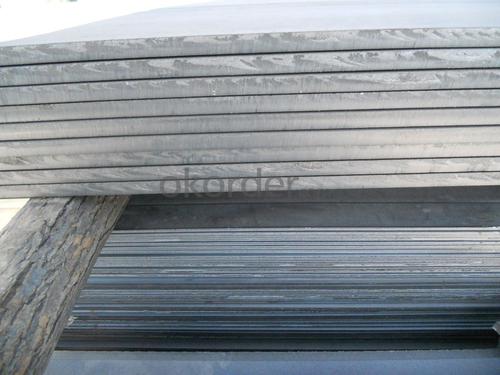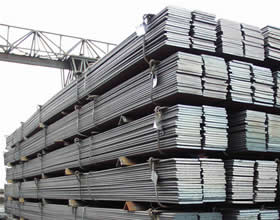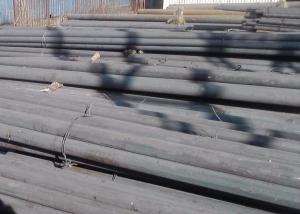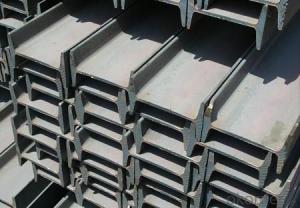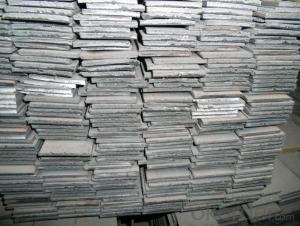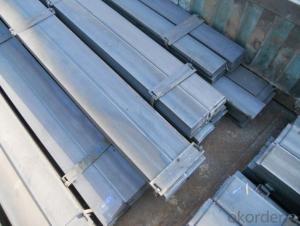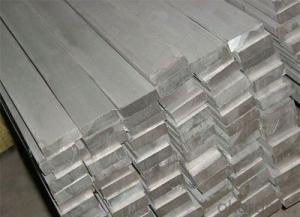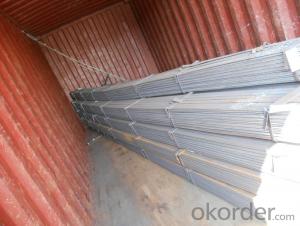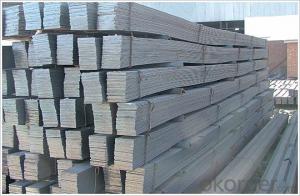Flat Bar Iron Steel Slitted
- Loading Port:
- China Main Port
- Payment Terms:
- TT or LC
- Min Order Qty:
- 100 m.t.
- Supply Capability:
- 10000 m.t./month
OKorder Service Pledge
OKorder Financial Service
You Might Also Like
OKorder is offering Flat Bar Iron Steel Slitted at great prices with worldwide shipping. Our supplier is a world-class manufacturer of steel, with our products utilized the world over. OKorder annually supplies products to African, South American and Asian markets. We provide quotations within 24 hours of receiving an inquiry and guarantee competitive prices.
Product Applications:
Flat Bar Iron Steel Slitted are ideal for structural applications and are widely used in the construction of buildings and bridges, and the manufacturing, petrochemical, and transportation industries.
Product Advantages:
OKorder's Flat Bar Iron Steel Slitted are durable, strong, and wide variety of sizes.
Main Product Features:
· Premium quality
· Prompt delivery & seaworthy packing (30 days after receiving deposit)
· Can be recycled and reused
· Mill test certification
· Professional Service
· Competitive pricing
Product Specifications:
Commodity: Mild Steel Flat Bar
Standard: GB;JIS
Material: Q195-235;SS400
Origin place: China
Thickness: 3mm-30mm
Width:20mm-200mm
Length: Max 12m
Certification: SGS/BV
Packaging: Export packing, nude packing, bundled
Alloy No | Grade | Element(%) | ||||
C
| Mn
| S
| P
| Si
| ||
Q235
|
B
|
0.12—0.20 |
0.3—0.7 |
≤0.045 |
≤0.045
|
≤0.3
|
Alloy No | Grade | Yielding strength point(Mpa) | Tensile strength (Mpa) | Elongation after fracture(%) | ||||||
Thickness (mm) | Thickness (mm) | |||||||||
≤16 | >16--40 | >40--60 | >60--100 | ≤16 | >16--40 | >40--60 | >60--100 | |||
≥ | ≥ | |||||||||
Q235 |
B |
235 |
225 |
215 |
205 |
375--500 |
26 |
25 |
24 |
23 |
FAQ:
Q1: Why buy Materials & Equipment from OKorder.com?
A1: All products offered byOKorder.com are carefully selected from China's most reliable manufacturing enterprises. Through its ISO certifications, OKorder.com adheres to the highest standards and a commitment to supply chain safety and customer satisfaction.
Q2: How do we guarantee the quality of our products?
A2: We have established an advanced quality management system which conducts strict quality tests at every step, from raw materials to the final product. At the same time, we provide extensive follow-up service assurances as required.
Q3: How soon can we receive the product after purchase?
A3: Within three days of placing an order, we will arrange production. The normal sizes with the normal grade can be produced within one month. The specific shipping date is dependent upon international and government factors, the delivery to international main port about 45-60days.
Images:
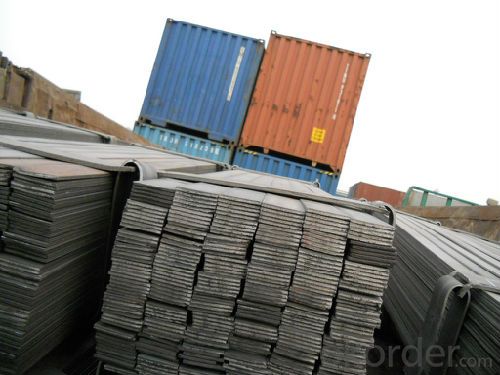

- Q:Can steel flat bars be used in food processing industries?
- No, steel flat bars cannot be used in food processing industries. The reason is that these flat bars are typically made of carbon steel, which can corrode and react with certain food substances. This can lead to contamination of the food and compromise its safety and quality. In food processing industries, it is essential to use materials that are food-grade and have high resistance to corrosion, such as stainless steel. Stainless steel is a preferred choice as it is non-reactive, easy to clean, and has excellent durability. Therefore, it is crucial for food processing industries to prioritize the use of stainless steel flat bars or other food-grade materials to ensure the hygiene and safety of the processed food products.
- Q:How is steel flat bar manufactured?
- The production of steel flat bar requires the use of raw materials, machinery, and skilled labor. The process begins by selecting high-quality steel, typically in the form of billets or slabs. These steel pieces are then heated in a furnace to increase their malleability. Once the steel has reached the desired temperature, it is passed through a series of rollers in a process known as hot rolling. Massive rotating rollers are used to shape the steel into a flat bar. The rollers apply high pressure to gradually reduce the thickness of the steel and increase its length. This process is repeated until the steel reaches the desired dimensions. After hot rolling, the steel flat bar may be subjected to pickling to eliminate any scale or impurities present on its surface. Pickling involves immersing the steel in an acid bath that chemically reacts with and removes the impurities. This step guarantees a clean and smooth surface finish. Once the desired surface finish is achieved, additional processes such as cold rolling or cold drawing may be employed to further refine the dimensions and improve the surface quality of the steel. Cold rolling entails passing the steel through rollers at room temperature, while cold drawing involves pulling the steel through a die to reduce its thickness and increase its length. Finally, the steel flat bar may undergo various finishing processes, including cutting, machining, or surface treatments, depending on its intended use. These processes ensure that the steel flat bar is cut to the required length and that its edges are smooth and free from any flaws. In summary, the manufacturing of steel flat bar involves a combination of heating, rolling, pickling, and finishing processes to transform raw steel into a versatile and widely used construction material.
- Q:Can steel flat bars be used for making tools or machinery parts?
- Yes, steel flat bars can be used for making tools or machinery parts. Steel is a versatile and commonly used material in the manufacturing industry due to its strength, durability, and resistance to wear and tear. Steel flat bars can be easily shaped, cut, and manipulated into desired tool or machinery parts, making them a popular choice for various applications. They can be used for constructing frames, supports, brackets, and other structural components in machinery or tools. Additionally, steel flat bars can be further processed through heat treatment or surface treatments to enhance their properties and improve their performance in specific applications. Overall, steel flat bars are a reliable and efficient material option for making tools or machinery parts due to their strength, versatility, and compatibility with various manufacturing processes.
- Q:How do steel flat bars compare to titanium flat bars?
- Both steel flat bars and titanium flat bars share some similarities, but they also have significant differences. When considering strength, titanium flat bars have a higher strength-to-weight ratio compared to steel flat bars. Titanium, a lightweight metal, possesses exceptional strength, making it perfect for applications that necessitate durability and lightness. On the other hand, steel is heavier but still sturdy, providing adequate strength for various purposes. In terms of corrosion resistance, titanium flat bars surpass steel flat bars. Titanium exhibits excellent corrosion resistance, even in harsh environments, rendering it highly suitable for applications in the marine, chemical, and aerospace industries. Conversely, steel is more susceptible to corrosion and requires protective coatings or regular maintenance to prevent rusting. Cost is another essential factor to consider. Generally, steel flat bars are more affordable than titanium flat bars. Titanium, being a relatively rare and expensive material, contributes to its higher price. On the contrary, steel is widely available and has a lower cost, making it a more cost-effective option for many applications. Moreover, titanium possesses unique properties that make it exceptional in certain industries. It showcases superb biocompatibility, making it valuable in medical and dental implants. Additionally, titanium is non-magnetic, making it useful in applications that require non-magnetic properties, such as aerospace and electronics. To summarize, titanium flat bars offer a higher strength-to-weight ratio, superior corrosion resistance, and distinctive properties like biocompatibility and non-magnetism. Steel flat bars, on the other hand, are more affordable while still providing satisfactory strength. Ultimately, the choice between the two will depend on the specific requirements of the application and the available budget.
- Q:Are steel flat bars suitable for making signage or display fixtures?
- Yes, steel flat bars are suitable for making signage or display fixtures. Steel flat bars offer a sturdy and durable option for constructing signage or display fixtures due to their strength and resistance to wear and tear. They can withstand heavy loads and provide stability, making them ideal for creating fixtures that need to hold and display various items or materials. Additionally, steel flat bars can be easily customized and shaped to fit specific design requirements, allowing for the creation of unique and eye-catching signage or display fixtures. Overall, steel flat bars are a reliable choice for making signage or display fixtures that will last for a long time while providing a professional and appealing appearance.
- Q:Can steel flat bars be used for automotive applications?
- Yes, steel flat bars can be used for automotive applications. They are commonly used in the manufacturing of various parts, such as brackets, supports, and frames, due to their strength, durability, and versatility.
- Q:What are the load capacities of steel flat bars?
- The load capacities of steel flat bars vary depending on various factors such as the dimensions (width, thickness, and length) of the bar, the type of steel used, and the specific application it is being used for. Steel flat bars are known for their high strength and durability, making them capable of supporting significant loads. However, it is important to consider the specific requirements and constraints of the application in order to determine the appropriate load capacity. Load capacities for steel flat bars can be calculated using engineering formulas and standards. These calculations take into account factors such as the maximum stress the bar can withstand without deformation or failure, the support conditions (e.g., whether the bar is fully supported or simply supported at both ends), and the distribution of the load along the length of the bar. It is advisable to consult engineering handbooks, codes, or professional engineers to accurately determine the load capacity of a specific steel flat bar for a particular application. They can provide the necessary calculations and guidance based on the specific requirements, ensuring that the load capacity is not exceeded and that the safety of the structure or component is maintained.
- Q:Are steel flat bars commonly used in the transportation industry?
- Indeed, steel flat bars find widespread usage within the transportation industry. Their application extends to the fabrication of diverse vehicle types, encompassing automobiles, trucks, and trailers. The utilization of steel flat bars yields manifold benefits, primarily in terms of their robustness and resilience, rendering them a prime selection for bolstering substantial burdens and enduring the arduous demands of transport. Furthermore, their malleability and weldability facilitate effortless shaping and joining, thereby affording flexibility in both design and construction. In summary, the indispensable role of steel flat bars in the transportation sector lies in furnishing indispensable structural reinforcement and ensuring the secure and effective conveyance of goods and individuals.
- Q:Are steel flat bars suitable for the construction of retail spaces or shopping centers?
- Yes, steel flat bars can be suitable for the construction of retail spaces or shopping centers. Steel flat bars are widely used in construction due to their strength, durability, and versatility. They can be used for various purposes such as framing, support beams, or even decorative elements. Steel flat bars provide excellent structural support and can withstand heavy loads, making them ideal for large commercial spaces like shopping centers. They are also resistant to fire, corrosion, and pests, ensuring a long lifespan and minimal maintenance requirements. Additionally, steel flat bars can be easily customized and fabricated to meet specific design requirements. They can be cut, welded, and shaped into different configurations, allowing for flexibility in architectural design. Furthermore, steel is a sustainable and environmentally-friendly material as it can be recycled and reused. This makes it an attractive option for retail spaces or shopping centers that aim to adopt green building practices and reduce their environmental impact. Overall, steel flat bars offer numerous advantages in terms of strength, durability, versatility, and sustainability, making them a suitable choice for the construction of retail spaces or shopping centers.
- Q:Can steel flat bars be used for manufacturing scaffolding or construction supports?
- Indeed, steel flat bars possess the capability to be utilized in the fabrication of scaffolding or construction supports. Owing to their robustness and resilience, steel flat bars have become highly favored. These bars can be effortlessly fused to form solid frameworks, capable of sustaining considerable weights. Moreover, steel flat bars exhibit commendable resistance against corrosion, rendering them ideal for outdoor construction ventures. Nevertheless, it remains imperative to ensure that the steel flat bars employed for scaffolding or construction supports adhere to the appropriate dimensions and quality, and comply with the essential safety standards and regulations.
1. Manufacturer Overview |
|
|---|---|
| Location | |
| Year Established | |
| Annual Output Value | |
| Main Markets | |
| Company Certifications | |
2. Manufacturer Certificates |
|
|---|---|
| a) Certification Name | |
| Range | |
| Reference | |
| Validity Period | |
3. Manufacturer Capability |
|
|---|---|
| a)Trade Capacity | |
| Nearest Port | |
| Export Percentage | |
| No.of Employees in Trade Department | |
| Language Spoken: | |
| b)Factory Information | |
| Factory Size: | |
| No. of Production Lines | |
| Contract Manufacturing | |
| Product Price Range | |
Send your message to us
Flat Bar Iron Steel Slitted
- Loading Port:
- China Main Port
- Payment Terms:
- TT or LC
- Min Order Qty:
- 100 m.t.
- Supply Capability:
- 10000 m.t./month
OKorder Service Pledge
OKorder Financial Service
Similar products
New products
Hot products
Hot Searches
Related keywords




